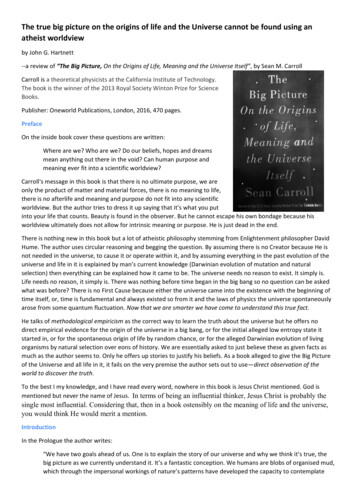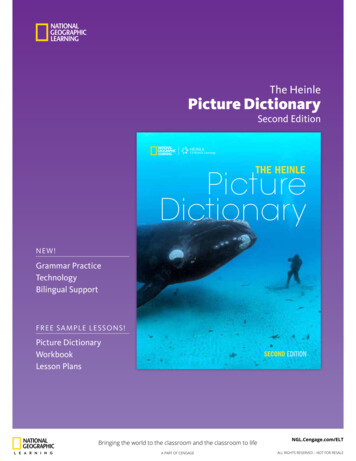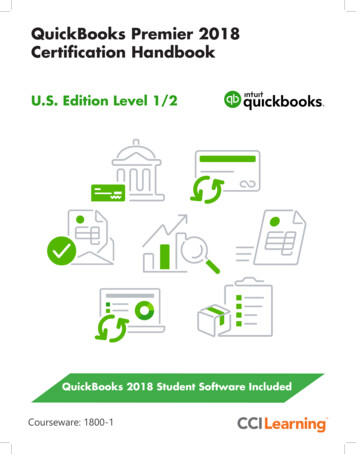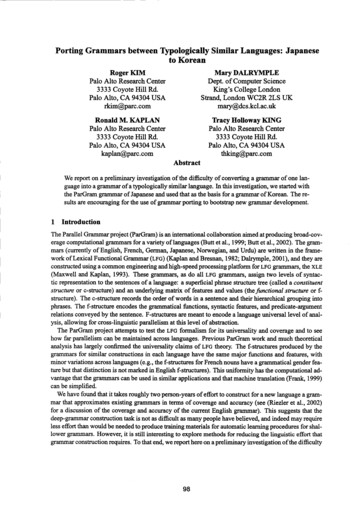
Transcription
The true big picture on the origins of life and the Universe cannot be found using anatheist worldviewby John G. Hartnett‐‐a review of “The Big Picture, On the Origins of Life, Meaning and the Universe Itself”, by Sean M. CarrollCarroll is a theoretical physicists at the California Institute of Technology.The book is the winner of the 2013 Royal Society Winton Prize for ScienceBooks.Publisher: Oneworld Publications, London, 2016, 470 pages.PrefaceOn the inside book cover these questions are written:Where are we? Who are we? Do our beliefs, hopes and dreamsmean anything out there in the void? Can human purpose andmeaning ever fit into a scientific worldview?Carroll's message in this book is that there is no ultimate purpose, we areonly the product of matter and material forces, there is no meaning to life,there is no afterlife and meaning and purpose do not fit into any scientificworldview. But the author tries to dress it up saying that it’s what you putinto your life that counts. Beauty is found in the observer. But he cannot escape his own bondage because hisworldview ultimately does not allow for intrinsic meaning or purpose. He is just dead in the end.There is nothing new in this book but a lot of atheistic philosophy stemming from Enlightenment philosopher DavidHume. The author uses circular reasoning and begging the question. By assuming there is no Creator because He isnot needed in the universe, to cause it or operate within it, and by assuming everything in the past evolution of theuniverse and life in it is explained by man’s current knowledge (Darwinian evolution of mutation and naturalselection) then everything can be explained how it came to be. The universe needs no reason to exist. It simply is.Life needs no reason, it simply is. There was nothing before time began in the big bang so no question can be askedwhat was before? There is no First Cause because either the universe came into the existence with the beginning oftime itself, or, time is fundamental and always existed so from it and the laws of physics the universe spontaneouslyarose from some quantum fluctuation. Now that we are smarter we have come to understand this true fact.He talks of methodological empiricism as the correct way to learn the truth about the universe but he offers nodirect empirical evidence for the origin of the universe in a big bang, or for the initial alleged low entropy state itstarted in, or for the spontaneous origin of life by random chance, or for the alleged Darwinian evolution of livingorganisms by natural selection over eons of history. We are essentially asked to just believe these as given facts asmuch as the author seems to. Only he offers up stories to justify his beliefs. As a book alleged to give the Big Pictureof the Universe and all life in it, it fails on the very premise the author sets out to use—direct observation of theworld to discover the truth.To the best I my knowledge, and I have read every word, nowhere in this book is Jesus Christ mentioned. God ismentioned but never the name of Jesus. In terms of being an influential thinker, Jesus Christ is probably thesingle most influential. Considering that, then in a book ostensibly on the meaning of life and the universe,you would think He would merit a mention.IntroductionIn the Prologue the author writes:“We have two goals ahead of us. One is to explain the story of our universe and why we think it’s true, thebig picture as we currently understand it. It’s a fantastic conception. We humans are blobs of organised mud,which through the impersonal workings of nature’s patterns have developed the capacity to contemplate
and cherish and engage with the intimidating complexity of the world around us. To understand ourselves,we have to understand the stuff out of which we are made, which means we have to dig deeply into therealm of particles and forces and quantum phenomena, not to mention the spectacular variety of ways thatthose microscopic pieces can come together to form organized systems capable of feeling and thought.The other goal is to offer a bit of existential therapy. By the old way of thinking, human life couldn’tpossibly be meaningful if we are ‘just’ collections of atoms moving around in accordance with the laws ofphysics. That’s exactly what we are, but it’s not the only way of thinking about what we are. We arecollections of atoms, operating independently of any immaterial spirits or influences, and we are thinkingand feeling people who bring meaning into existence by the way we live our lives.” (p.3)The latter he has to say because later he talks about the material world is all there is. He argues that there is no suchthing as a spirit or a soul that is not part of our material body. When we die that is it, there is nothing beyond life.Carroll is a student of many philosophers, mostly atheists, or who are at least those who challenge a conservativeworldview of life. For example he mentions, Descartes, Nietzsche, Laplace, Hume, Leibniz, Spinoza, Lewis, Russell,Wittgenstein, Kierkegaard and others. But it would seem that the author relies more strongly on the so‐calledEnlightenment philosophy of the atheist Scotsman David Hume.His claim is that the Core Theory—the standard quantum field theory of particle physics—is the correct theory todescribe everything in the realm of human existence.“ we have extremely good reason to think that the Core Theory is the correct description of nature in itsdomain of applicability. That domain is wide enough to immediately exclude a number of provocativephenomena: from telekinesis and astrology to survival of the soul after death.” (p.4)The existence of the soul is lumped in with pseudo‐sciences such as astrology and telekinesis. That seems to showhis ignorance for what real biblical Christians actually believe. It is disingenuous, in my view, to lump the survival ofthe soul after death in with various parapsychological beliefs, which would be condemned by God.He is a believer in materialism at its very core, and as such promotes naturalism, in a form he calls poetic naturalism,as developed by David Hume. In that, apparently, we can find a meaning for life.“Purpose and meaning of life arise through fundamentally human acts of creation, rather than being derivedfrom anything outside our selves” (p.11).He clearly states his religion, which he attempts to justify in the book.“In the right circumstances, matter self‐organizes into configurations, capable of capturing and usinginformation from their environments. The culmination of this process is life itself.” (pp. 4‐5)“At a fundamental level, there aren’t separate ‘living things’ and ‘nonliving things,’ ‘things here on Earth’ and‘things up in the sky,’ ‘matter’ and ‘spirit.’ There is just the basic stuff of reality, appearing to us in manydifferent forms.” (p.12)The overall thread of his book describes how that mankind has become more and more knowledgeable of hownature operates and, as such, we no longer need to think in terms of anything other than a material world. There isnothing else—nothing else is needed to explain everything we know. There are no gods, no Creator, no spirits, nosoul. All is matter and how the laws of physics operate on that matter.The book is divided into six sections: they are titled Cosmos, Understanding, Essence, Complexity, Thinking, and thelast section is Caring.“Finally, in ‘Caring’ we confront the hardest problem of all, that of how to construct meaning and values in acosmos without transcendent purpose. Poetic naturalism (the form he subscribes to) strikes a middleground, accepting that values are human constructs, but denying that they are therefore illusory ormeaningless. The meaning we find in life is not transcendent, but it’s no less meaningful for that.” (p.5)
He tries to hold the view that there can be found excitement and meaning in life whilst knowing on the other handthat there is no ultimate purpose.“As we understand the world better, the idea that it has a transcendent purpose seems increasinglyuntenable.” (p.9)And says the problem occurs because we have not fully accepted the atheist view of life. That is, that there is noCreator, and all life evolved from pond scum over the past several billion years.“Over the course of the last two centuries, Darwin has upended our view of life.” (p.10)“It’s a bit of a leap, in the face of all of our commonsense experience, to think that life can simply start upout of non‐life, or that our experience of consciousness needs no more ingredients than atoms obeying thelaws of physics. Of equal importance, appeals to transcendent purpose or higher power seem to provideanswers to questions to some of the pressing ‘Why?’ questions we humans like to ask: Why this universe?Why am I here? Why anything at all? Naturalism, by contrast, simply says: those aren’t the right questions toask.” (p.13)And admits that“It’s a lot to swallow, and not a view that anyone should accept unquestioningly”. (p.13)And“We don’t know how the universe began, of if it’s the only universe. We don’t know how life began, orhow consciousness arose.” (p.13)If you don’t know how, then probably you don’t know why. So how can he answer the ‘Big Picture’ questions when,within the first 13 pages, he admitted that the naturalists have no idea and instead says that such ‘why?’ questionsare invalid?NaturalismCarroll defines naturalism saying it comes down to three things (p.20) and that “the only reliable way of learningabout the world is by observing it”. But how can he know that if he is not God. Suppose for a minute that there reallyis a Creator God and He gave us a revelation in His written Word. But because man cannot, by definition, observeGod, since He is a spirit and outside the realm of detectability by science, how can he know that what God haswritten is not a reliable way of learning about the world? And this is another self‐refuting claim: what observationdid he make, or even could he make, that reliably showed that observation is the only reliable way of learning?His form of naturalism – poetic naturalism (after David Hume) – is just standard atheistic naturalism, but he addsthat man has responsibility and freedom (p.21).“The world exists; beauty and goodness are things that we bring to it.”He means there is nothing intrinsically good or beautiful. He writes that there are“No causes, whether material, formal, efficient, or final” (p.29).Extending the idea of Laplace’s Demon, he writes“Realistically, there never will be and never can be an intelligence vast and knowledgeable enough to predictthe future of the universe from its present state.” (p.34)In the chapter titled “Reasons Why” he says that Leibniz’s Principle of Sufficient Reason is a mistake. That principlestates that “For any true fact, there is a reason why it is so, and why something else is not so instead” (p.40). And hepoints out that“Hume noted that conceiving of effects without causes might seem unusual, but it does not lead to anyinherent contradiction or logical impossibility.” (p.41)This leads to his belief that the universe needs no reason to be; it simply is.
“ there are facts that don’t have any reasons to explain them”. (p.42)He implicitly believes a big bang origin for the universe 14 billion years ago, and says that there are some questionsfor which we may not get answers.“We have to be open to the possibility that they are brute facts, and that’s just how things are.” (p.45)“But we should be at peace with the possibility that, for some questions, the answer doesn’t go any deeperthan ‘that’s what it is.’” (p.46)Carroll talks about science as what we can measure experimentally but then in regards to the alleged big bang heappeals to faith, using the big bang model (theory not experimental results) to test the big bang model (theory). Thisis common practice among astronomers. He admits this in regards to measurement of the alleged expansion of theuniverse.“If you focused on a particular faraway galaxy and measured its velocity, then came back a few million orbillion years later and measured it again, you would find that it’s now moving away from you even faster.(That’s not what the astronomers did, of course; they compared the velocities of galaxies at differentdistances.) If this behavior continues forever—which seems quite plausible—the visible universe willcontinue to expand and dilute in perpetuity.” (p.52)Figure 1: Light from distant galaxies shows spectral like shifted towards the red end of the spectrum. Hence they are labelled'redshifted'. Only spectral lines are measured, not recession speeds.The problem is that he has assumed the big bang model to be the true description of the Universe to provideevidence for the description of the Universe. Galaxy velocities are not measured but their redshifts. A velocity is aninterpretation based on general relativity that a galaxy’s redshift implies a recession speed. But it does notnecessarily follow as there are many other possible mechanisms that could give rise to redshifts.1Secondly the big bang model is assumed by applying the assumption that galaxies at different redshifts represent thestate of the universe at past epochs classifies by those redshifts. This is the cosmological principle in application. Itstates that there are no special places in the universe and all locations at the same epoch of time look the same. Thusyou can use galaxies at any redshift as representative of the state of the whole universe at that time.But the latter can only be assumed, without proof. In fact, cosmology itself is an historical science (at best) and moreakin to trying to reconstruct the history of the rocks from sedimentary layers or past life from the fossils buried inthose rocks.At the end of the chapter on our universe he opines about our existence and purpose.“We are small, and the universe is large. It’s hard, upon contemplating the scale of the cosmos, to think thatour existence here on Earth plays an important role in the purpose or destiny of it all. . A crucial questionalong the way is, why did the matter in the universe evolve over billions of years in such a way as to createus?” (p.53)All the glory to the universe! Or so it would seem. This is what the book is essentially preaching.Considering how these atheist apologists operate, not only Carroll, but also Krauss, Tyson, Hawking, Dawkins andothers, there is often really little effort focused on real operational science but more on presenting unprovable‐historical‐science stories dressed up as real science. The tone of this book, though at times the author admits to theshortcomings of our current knowledge, is not critical of the evolutionary stories, but only of minor details that yet
need to be filled in. To state to a general audience that velocities of galaxies are measured (for example) withoutqualification, because it fits into the story‐line, is tantamount to being deceptive. This book like many others alongthe same line attempts to sell a message—a philosophical worldview—dressed up as science.Nowhere does the author address the impossibility of doing real science on the Universe, nor does he explain thelimitations of cosmological investigations.The following paragraphs, excerpted from a 2007 article published in the prestigious journal Science, include quotesfrom three well‐known cosmologists.2 Square brackets are my insertions.Researchers have measured the temperature variations in the CMB [Cosmic Microwave Backgroundradiation] so precisely that the biggest uncertainty now stems from the fact that we see the microwave skyfor only one Hubble volume [i.e. only one possible observable universe], an uncertainty called cosmicvariance. ‘We’ve done the measurement,’ [Charles] Bennett says.That barrier to knowledge, some argue, is cosmology’s Achilles’ heel. ‘Cosmology may look like a science, butit isn’t a science,’ says James Gunn of Princeton University, co‐founder of the Sloan survey. ‘A basic tenet ofscience is that you can do repeatable experiments, and you can’t do that in cosmology.’‘The goal of physics is to understand the basic dynamics of the universe,’ [Michael] Turner says. ‘Cosmologyis a little different. The goal is to reconstruct the history of the universe.’ Cosmology is more akin toevolutionary biology or geology, he says, in which researchers must simply accept some facts as given.(emphases added)Arrow of TimeIn the chapter titled “Time’s Arrow” he states that the arrow of time seen in human aging and in the evolution of thebig bang universe are “intimately related”.“The reason why we are all born young and die older; the reason why we can make choices about what to donext but not about things we’ve already done; the reason why we remember the past and not the future—all of these can ultimately be traced to the evolution of the wider universe, and in particular to conditionsnear its very beginning, 14 billion years ago at the Big Bang.” (p.54)“The reason why there’s a noticeable distinction between past and future isn’t because of the nature oftime; it’s because we live in the aftermath of an extremely influential event: the Big Bang.” (p.55)The notion of purpose is discarded in favour of just everything that happens, including aging and our memories, arethe result of the big bang. It reads like worship of the big bang. It is the reason for our existence and must be givendue credit, even credit for the existence of time itself.He discusses the special condition that the Universe allegedly started in, that is, in a low state of entropy from whichentropy (or disorder) has ever since increased as a function of time. He states that this gave rise to the well‐known“thermodynamic” arrow of time. Later he credits this initial low entropy state and subsequent progression ofexpansion and increasing entropy as the cause for growth in complexity everywhere and even the origin of life itself.“Nobody knows exactly why the early universe had such a low entropy. It’s one of those features of ourworld that may have a deeper explanation we haven’t yet found, or may just be a true fact we need to learnto accept.” (p.58)Thus Carroll ultimately appeals to a ‘god of the gaps’. And his god seems to be the big bang itself. But the evidence isbetter interpreted as being consistent with a uniquely created Universe. The Universe was created by the self‐existent One, the eternal I AM, who is outside of time. He created the Universe in an initial low entropy state (not ina big bang) and created all life within it.The Creator is the First Cause. The initial low entropy state implies a beginning. Anything that has a beginning has afirst cause. Only an eternal uncreated being can be that first cause and He is God.
Figure 2: On billboards across AmericaUnderstanding the WorldCarroll devotes a few chapters to assessing how well we understand the world. He introduces us to Rev. ThomasBayes who, in the latter part of his life, studied probability. He was published posthumously on the subject. His workhas become widely used in mathematics, principally statistics, and also in physics. The subject has become to beknown as Bayesian inference or Bayesian probability.Bayes’ main idea involves how to treat the probability of a proposal being correct in the light of new evidencebecoming available. In physics we rely on what we already know, or what we think we have established asfoundational and we build upon that. When we get new information that could change our view we need to updatewhat we believe is the probability of the hypothesis being correct in light of that new information. That probability iswhat is called a credence, or the degree of belief that we hold that we are correct.So Bayesian inference attempts to apply a quantitative value to what we might infer from our attempts to explainthe physical world. It is the basis of scientific investigation. In terms of experimental discoveries it is easy to see howthis might apply. We can never prove any hypothesis or theory correct. All we can hope to do is update ourcredence, meaning to increase the probability of a theory being correct. In physics a threshold is established of 5 (5sigma) above which it is said that a discovery has been made. Statistically that is like saying there is only 1 in a 3.5million chance that the signal isn't real and thus the theory is wrong. That is a very low probability indeed. But somediscoveries have been made at the level of 3 or less.3 I know of one hypothesis that had a 6 probability yet itturned out to be wrong.4But things don’t always work out to be correct, even with a statistical probability above 5 . Any hypothesis may berefuted but it can never be proven. Do you remember the claim of faster than light neutrinos in 2011? The OPERAteam’s experimental results indicated a 6 level of confidence, which is much higher than the 5 usually required fornew particle discoveries. But in the following year, as many expected (because we don’t expect any particle to breakthe speed of light limit), an error was found in the experimental analysis resulting from a loose fibre optic cable,5 andthat meant those neutrinos obeyed the universal speed limit. When the new information came in the Bayesiancredence could be updated to nearly zero.Ironically, after discussing this affair, Carroll states the following:“There is an old joke about an experimental result being ‘confirmed by theory,’ in contrast to theconventional view that theories are confirmed or ruled out by experiments.” (p.74)The irony is that he claims that the case of past evolutionary change is established beyond reasonable doubt by theevidence, like the fossil record, yet at the same time admitting that we have no way to make an observation on thepast.
It is true that if a good theory comes to hand to explain evidence, whether that be in the present, in terms of directlyrepeatable operational science, or evidence related to past events, it increases our prior credence to the claim in thefirst place.Yet throughout the book, when discussing what we do learn from the world in terms of the origin of life, andevolution, they are never doubted, only a story is resorted to, to explain what the evidence does not. In other words,despite his claim to update his own Bayesian credence, when evidence at hand does not help explain theevolutionary story, he maintains his degree of belief in abiogenesis and Darwinian evolution despite the evidence.He resorts to hope in something else, not yet discovered or understood.Yet of others he writes:“People have certain views that they’re just never going to change, which in Bayesian language correspondsto priors set to 0 or 1. That is too bad, something we need to learn to deal with in the real world. But inprinciple, if we are all trying to be fair and open‐minded and willing to change our beliefs in the face of newinformation, evidence will win in the end.” (pp.80‐1)In practice I find that atheists are not open‐minded. They have a high prior credence on ‘Darwinian evolution is afact’, despite it not being observable in the lab. And I am not referring to natural selection, though a quick change ofthe meaning of the word ‘evolution’ is often used in the same sentence. That is called equivocation.Through the book, Carroll makes some statements, where on the surface he seems to place a little credence in theproposition that ‘God created the universe’ but in reality (on page 80 for example) he assigns it a credence of next tozero. He bases that belief in the fact, as he claims, that the natural world can explain everything. He would say theopposite is true for me, that I have a prior credence of zero in Darwinian evolution and that I do not base my beliefon science. On the contrary, if this book is about updating our prior credence based on new information then as thedecades have rolled by my credence or belief in Darwin’s theory has gotten smaller and smaller. The evidence hasbeen stacking up against it and the same can be said of abiogenesis and the alleged uncaused big bang origin of theUniverse.Despite what Carroll claims, evidence never does ‘win in the end’. That is a false narrative. All evidence must beinterpreted and whoever does the interpreting is always influenced by his/her worldview—the belief system we allhave. This is particularly important when we are dealing with past events—events to which we have no direct access.Carroll in no way addresses this issue, nor even recognises that there is an issue there.In the chapter titled “Is it okay to doubt everything?” he discusses Descartes philosophical reasoning that not only heexists but also that God must exist. Carroll agrees with Descartes on his hypothesis that we cannot be sure ofanything. In other words Carroll advocates that we cannot be absolutely sure of anything at all. We may not even bereal—but instead living in some computer simulation asillustrated in the movie The Matrix.Figure 3: Image from The Matrix a 1999 science fiction film, whereinthe occupants are unaware that they live in a simulated world.From there he pointed to Philip Henry Gosse and his bookOmphalos wherein Gosse tried to reconcile the alleged old ageof the earth (millions of years) with that inferred from the Bible(thousands of years).“His idea was simple: God created the world a few thousand years ago, but with all the signs of being mucholder, including mountain ranges that would take millions of years to form, and fossils of apparently greatantiquity.” (pp.87‐8)Of course, Gosse was seriously wrong.6 No biblical creationist would suggest such a scenario. However, God createdincorporating functional maturity, not ‘appearance of age’ into His creation.What Gosse did not know is that the mountains and fossils do not indicate ages of millions or billions of years, quitethe opposite. Fossils and sedimentary layers are, in fact, only dated by fitting them into the evolution story. But
fossils date the rock layers and the rock layers date the fossils. It is completely circular. They are not dated by someabsolute dating technique. Carroll should have said so.But instead he wrote:“Versions of his idea are promoted to this day by some Christian and Jewish creationists, who use it toaccount for cosmological evidence of light that left distant galaxies billions of years ago.” (p.88)He must be referring to the idea that starlight was created in transit to explain light travelling vast distances in auniverse only 6000 year old. On this point I agree with him. It is a very poor, ill‐thought‐through explanation. Butthere are several far better explanations that in no way limit the veracity of the Creator’s word.7RealismIn the chapter titled “Reality Emerges” Carroll suggests a world “profoundly different from the picture we constructfrom our everyday experience” (p.93). This is where, according to him, the Universe is endowed with propertieseveryday objects would not get.“There is conservation of momentum: the universe doesn’t need a mover; constant motion is natural andexpected. It is tempting to hypothesize that the universe doesn’t need to be created, caused, or evensustained. It can simply be.” (p.93, emphasis in original)This is really like the early twentieth century philosophers and cosmologists. Striving to avoid a beginning in time orof time, or striving for some sort of stasis in the cosmos, i.e. Sir Fred Hoyle and the Steady State model. Cosmologistsback in the 1950’s had the same sort of thoughts. They believed in an eternal universe that had no beginning and noend. They believed it was uncreated – without a Creator.Speaking of the conservation momentum and information in the Universe, Carroll states:“These discoveries indicate that the world operates by itself, free of any external guidance. Together theyhave dramatically increased our credence in naturalism: there is only one world, the natural world, operatingaccording to the laws of physics.” (p.93)This begs the question. The modern scientific methodology only operates or tests the natural world. You wouldexpect only to get natural results; nothing preternatural is expected nor obtained. As a result atheopaths, likeCarroll, claim there is nothing else. But blindness to the fact that the natural world and the laws of physics are theCreator’s handiwork means that the blind guides overlook the Creator Himself. A fully wound clock will operate byitself—until it is run down and deleted of free energy to do work. It is free of external influences but does that meanwe can conclude that the clock doesn’t need to be created, caused or even sustained. It simply is?In this chapter he lists (on page 102) what he calls important phase transitions in the history of the Universe. Thesejust evolved out of the cosmic soup starting with the big bang, allegedly. Square brackets [] are my insertions. The formation of protons and neutrons out of quarks and gluons in the early universe. [An untestable belief;you can’t repeat the alleged event.]Electrons combining with atomic nuclei to make atoms, several hundred thousand years after the Big Bang.[An untestable belief; you can’t repeat the alleged event.]The formation of the first stars, filling the universe with new light. [This is a particularly difficult problem.Unseen exotic dark matter is invoked to solve it.]The origin of life: a self‐sustaining complex chemical reaction. [That is all life is to an atheist. Nevertheless,no one has any idea how life began in the evolutionary world.]Multicellularity, when different living organism merged to become one. [This is where Darwinian evolution,natural selection operating on mutations is assumed to be the driving force. But genetics just won’t allowthe mixing of genetic information this way. Gene duplication and transmission is a highly conservativeprocess. Only with a lot of intelligence has man been able to add existing genes to foreign organisms.]Consciousness: the awareness of self
The true big picture on the origins of life and the Universe cannot be found using an atheist worldview by John G. Hartnett ‐‐a review of “The Big Picture, On the Origins of Life, Meaning and










